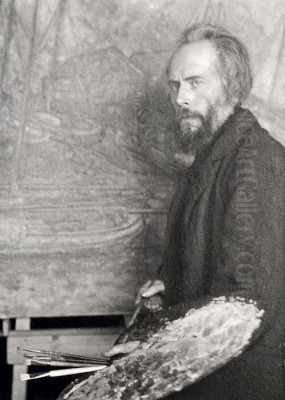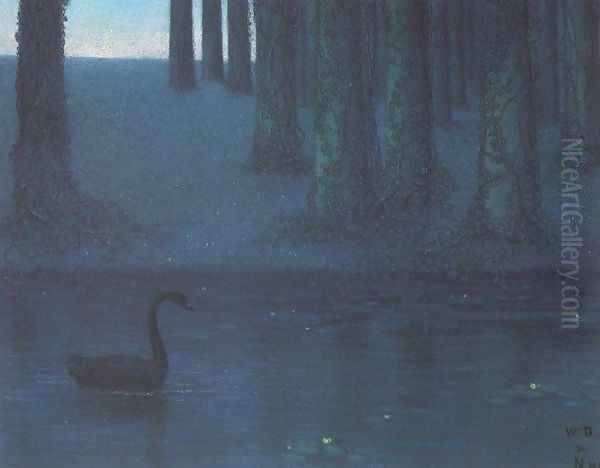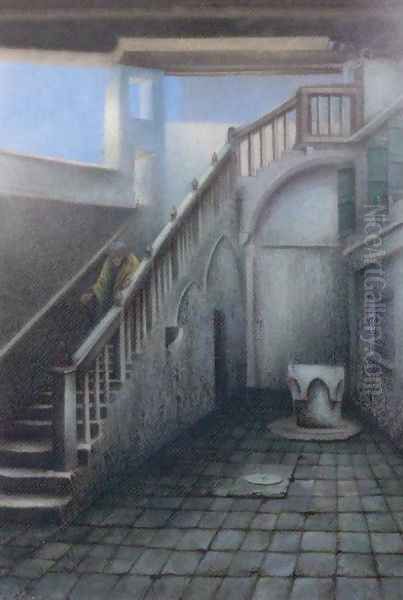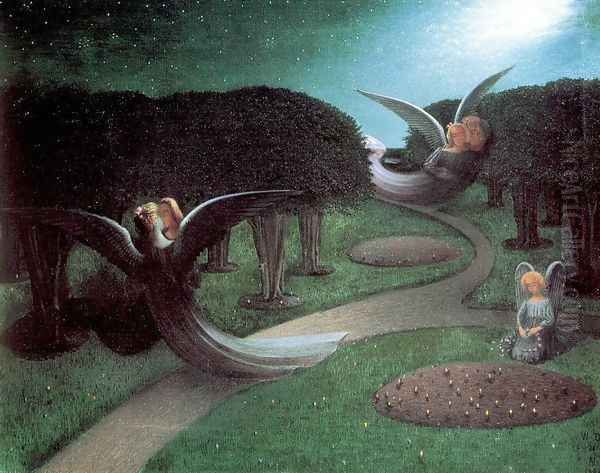
William Degouve de Nuncques stands as a significant yet often subtly acknowledged figure within the rich tapestry of late nineteenth and early twentieth-century European art. A pivotal Belgian Symbolist painter, his work resonates with a unique sensitivity to atmosphere, mystery, and the evocative power of light, particularly during the liminal hours of twilight and night. His canvases and pastels invite viewers into landscapes of the mind, where reality blends seamlessly with dream, and silence speaks volumes. Born into an era of artistic ferment, Degouve de Nuncques carved a distinct path, influencing subsequent movements and leaving behind a legacy of hauntingly beautiful, introspective art.
Early Life and Artistic Beginnings
William Degouve de Nuncques was born on February 28, 1867, in Monthermé, located in the Ardennes region of France. He hailed from an old, aristocratic family, a background that perhaps instilled in him a certain independence of spirit and a predisposition towards contemplation, which would later permeate his artistic output. His early life was marked by the turbulence of the Franco-Prussian War (1870-1871). Following the conflict, his parents made the decision to relocate the family, settling in Belgium. This move proved decisive for his future artistic identity, firmly planting him within the burgeoning Belgian art scene.
Unlike many of his contemporaries who followed traditional academic routes, Degouve de Nuncques was largely self-taught as a painter. This path of independent learning likely contributed to the highly personal and unconventional nature of his vision. Free from the rigid constraints of academic training, he was able to cultivate his innate sensibilities, drawing inspiration directly from his observations, his readings, and his interactions with fellow artists who shared his quest for deeper meaning beyond surface appearances. His family's financial security meant he did not face the immediate pressure to produce commercially viable work, allowing him the freedom to explore his unique artistic inclinations.
Embracing Symbolism

The late nineteenth century in Belgium, particularly in Brussels, was a vibrant hub for avant-garde art. Degouve de Nuncques quickly found himself drawn into these progressive circles. He formed crucial friendships that would shape his early career, notably with the Dutch artist Jan Toorop and the Belgian painter Henry de Groux. These figures, themselves exploring Symbolist and other innovative styles, likely provided encouragement and intellectual exchange for the developing artist. His association with these like-minded individuals helped solidify his direction.
A defining moment in his integration into the avant-garde was his involvement with the influential exhibition society known as "Les XX" (Les Vingt), founded in 1883. Les XX was instrumental in promoting modern art in Belgium, showcasing works by both Belgian innovators like James Ensor and Fernand Khnopff, and international figures such as Georges Seurat and Paul Gauguin. Degouve de Nuncques became a member, exhibiting alongside these prominent artists. Later, he also participated in the successor group, "La Libre Esthétique," which continued the mission of Les XX after its dissolution in 1893. These affiliations placed him at the very heart of Symbolist activity.
His immersion in Symbolist circles was further deepened by his marriage to Juliette Massin, a fellow artist and poet. Massin introduced him more formally into the Symbolist milieu, connecting him with writers and thinkers who shared an interest in the subjective, the spiritual, and the mysterious. Symbolism, as a movement, rejected the purely objective representation favored by Realism and Impressionism, seeking instead to evoke ideas, emotions, and states of mind through suggestive imagery, personal symbols, and atmospheric effects. Degouve de Nuncques's temperament and artistic inclinations aligned perfectly with these goals.
The Language of Night and Dreams
Degouve de Nuncques developed a highly distinctive visual language, becoming particularly renowned for his depictions of nocturnal and crepuscular scenes. His landscapes are often devoid of human figures, or feature them minimally, emphasizing instead the evocative power of place and atmosphere. Parks shrouded in mist, silent city squares under gaslight, moonlit canals, and shadowy forests became his signature subjects. He possessed an extraordinary ability to capture the subtle gradations of light at dusk, dawn, or in the dead of night, transforming ordinary locations into realms of enchantment and quiet unease.

His use of color was integral to this effect. Often employing a palette of deep blues, greens, mauves, and silvery grays, punctuated by the artificial glow of lamps or the ethereal light of the moon, he created a sense of profound stillness and introspection. Fog and mist frequently veil his scenes, softening forms and adding layers of mystery. This focus on atmosphere over precise detail aligns perfectly with the Symbolist aim of suggestion rather than explicit statement. His works are not mere topographical records; they are visual poems, meditations on solitude, silence, and the hidden life of the world when darkness falls.
The recurring motifs in his work – silent parks, ancient trees, reflective water, empty pathways – often carry symbolic weight, though their meanings remain ambiguous and open to interpretation. They speak to themes of introspection, the passage of time, the relationship between nature and the man-made world, and an underlying sense of the mystical or the uncanny lurking just beneath the surface of the visible. His paintings invite contemplation, drawing the viewer into their quiet, dreamlike spaces.
Masterworks of Mystery
Several key works exemplify Degouve de Nuncques's unique contribution to Symbolism and hint at his forward-looking vision. The Pink House (La Maison Rose), painted in 1892, is perhaps his most famous and frequently discussed painting. It depicts a solitary house, bathed in the warm, artificial light emanating from its windows, set against the deep blue of a nocturnal sky and landscape. The juxtaposition of the inviting interior light and the mysterious, potentially menacing darkness outside creates a powerful sense of ambiguity and psychological tension. The work's unsettling atmosphere and its stark contrast between light and dark have led many art historians to see it as a significant precursor to Surrealism, notably influencing René Magritte's famous Empire of Light series, which similarly explores the paradoxical combination of day and night.
The Angels (Les Anges) from 1894 presents a more overtly mystical theme. While interpretations vary, the work typically features ethereal, perhaps slightly unnerving, angelic figures within a landscape, rendered with his characteristic soft focus and atmospheric handling. It delves into the spiritual and supernatural interests that were common among Symbolist artists and writers, exploring realms beyond the purely material.
The Peacocks (Les Paons), painted in 1896, utilizes another potent Symbolist motif. The peacock, with its extravagant beauty, could symbolize vanity, immortality, or otherworldly splendor. Degouve de Nuncques places these birds within one of his signature park settings, likely at twilight, their forms contributing to the overall sense of decorative richness and enigmatic meaning characteristic of the movement.

Another crucial work is The Blind House (La Maison Aveugle). Similar in theme to The Pink House, it often depicts a building with darkened or shuttered windows, suggesting hidden life, secrets, or an introspective state. The title itself evokes a sense of mystery and the unseen. This painting, too, is frequently cited for its proto-Surrealist qualities, tapping into subconscious fears and the uncanny nature of familiar structures transformed by darkness and silence.
Other notable works mentioned in various sources, such as Forest Interior, Black Swan, Venice, and Disaster, further illustrate his range. Forest Interior likely explores the mysterious depths of nature, while Black Swan employs another symbolically rich creature. His depictions of Venice would capture the city's unique nocturnal atmosphere and watery reflections, and a title like Disaster suggests a move towards expressing more overt emotional or psychological states, perhaps reflecting later developments in his life and art.
Pastel and Technique
While Degouve de Nuncques worked in oils, he became particularly celebrated for his mastery of pastel. This medium, with its powdery texture and potential for subtle blending and layering, proved exceptionally well-suited to his artistic aims. Pastels allowed him to achieve the soft, velvety textures, diffused light, and delicate tonal transitions that define his most atmospheric works. The inherent luminosity of pastel pigments helped him capture the ethereal glow of moonlight or the soft haze of twilight with remarkable sensitivity.
Sources suggest that particularly later in his career, possibly after 1919 following personal hardships, he turned almost exclusively to pastels. Whether this was due to preference or necessity (perhaps related to the reported loss of function in his right hand), his proficiency with the medium is undeniable. His technique often involved building up layers of color, smudging and blending to create seamless transitions and a sense of depth and vibration. Unlike the sharp clarity sought by some artists, Degouve de Nuncques often embraced a slightly blurred or softened focus, enhancing the dreamlike, suggestive quality of his imagery. His handling of pastel is not merely technical skill; it is integral to the mood and meaning of his art.
His compositions often feature strong underlying geometric structures – the lines of pathways, the shapes of buildings, the verticals of trees – which provide a sense of order beneath the atmospheric veil. This combination of structural solidity and ethereal light effects creates a unique tension and balance within his work. The quietude and stillness are palpable, achieved through both his choice of subject matter and his refined, sensitive technique.
Connections and Contemporaries
Degouve de Nuncques did not operate in isolation. His artistic journey was interwoven with the broader currents of European art and his personal connections within the Symbolist movement. His early mentors, Jan Toorop and Henry de Groux, provided foundational support. His participation in Les XX and La Libre Esthétique placed him in direct dialogue with leading Belgian artists like the enigmatic Fernand Khnopff, known for his silent, mysterious portraits and scenes, and the highly individualistic James Ensor, whose work ranged from dark satire to luminous still lifes. He also shared a certain sensibility with Léon Spilliaert, another Belgian master of evocative, often melancholic coastal scenes and interiors.
His work resonated with prominent figures beyond Belgium. He exhibited regularly in Paris, the epicenter of the art world, where his unique vision garnered appreciation. Notably, established artists like Pierre Puvis de Chavannes, a major precursor of Symbolism known for his serene, allegorical murals, and Maurice Denis, a key theorist and painter associated with the Nabis group (which shared Symbolist roots), were among those who admired his work. This recognition underscores his relevance within the wider European Symbolist context.
The influence of Symbolist literature was profound. His close association with poets like Emile Verhaeren and the Nobel laureate Maurice Maeterlinck, both central figures in Belgian Symbolism, undoubtedly informed his thematic concerns and his pursuit of mood and suggestion over narrative clarity. His art often feels like a visual counterpart to their evocative, atmospheric writing.
Furthermore, Degouve de Nuncques was a traveler. He spent time in various European locations, including Italy and Spain. His period in Majorca between 1899 and 1902 was particularly significant, bringing him into contact with Spanish and Catalan artists. Figures like Santiago Rusiñol, a Catalan painter associated with Modernisme (the Catalan variant of Art Nouveau and Symbolism) who also painted evocative garden scenes, were part of this milieu. These travels broadened his horizons and likely introduced new motifs and light effects into his work.
Comparisons can also be drawn with major French Symbolists like Odilon Redon, who similarly explored dreamlike states and fantastical imagery, often favoring pastels and charcoal for their suggestive qualities. While Degouve de Nuncques's focus remained more grounded in landscape and cityscape, he shared with Redon a profound interest in the inner world and the power of the imagination.
Later Years and Personal Trials
The trajectory of an artist's life often impacts their work, and Degouve de Nuncques was no exception. Around 1910, sources indicate he experienced a significant "religious crisis." While the specific nature of this crisis is not fully detailed, it is suggested that this period led to a shift in his art, making it perhaps more intensely personal, introspective, or emotionally charged. It may have deepened his exploration of spiritual themes or altered his perspective on the mystical elements present in his earlier work.
A profound personal tragedy struck in 1919 with the death of his wife, Juliette Massin. This loss was compounded by a devastating physical blow: shortly thereafter, Degouve de Nuncques reportedly lost the functional use of his right hand. For a painter, particularly one known for the sensitivity of his touch, this must have been an immense challenge. It is perhaps during this period that his reliance on pastel, potentially wielded with his left hand or adapted techniques, became more pronounced.
Despite these hardships, he continued to create art. The works from his later period might reflect these experiences, possibly imbued with a deeper melancholy or a different kind of spiritual searching. His art, always focused on internal states and atmospheric suggestion, likely became an even more crucial outlet for processing his personal world after these trials. His travels and exhibitions continued, indicating a persistent dedication to his artistic vocation even in the face of adversity.
Legacy and Art Historical Significance
William Degouve de Nuncques occupies a vital position in the history of Belgian and European Symbolism. He is recognized as one of the foremost interpreters of the Symbolist landscape, transforming parks, cities, and forests into stages for psychological and spiritual drama. His mastery of atmosphere, particularly his evocative nocturnal scenes rendered with exquisite sensitivity in pastel, remains his most distinctive contribution.
His significance extends beyond Symbolism. Works like The Pink House and The Blind House are consistently highlighted for their anticipation of Surrealism. Their uncanny atmosphere, exploration of the subconscious, and juxtaposition of the familiar and the strange prefigure the dreamscapes that would dominate Surrealist painting several decades later. His direct influence on René Magritte is well-documented, cementing his role as a bridge figure between these two major modern art movements.
While perhaps not as widely known internationally as some of his contemporaries like Ensor or Khnopff, Degouve de Nuncques holds a secure place within art history. His work is valued for its poetic intensity, technical refinement (especially in pastel), and its unique focus on the suggestive power of light and shadow. He demonstrated how landscape painting could transcend mere representation to become a profound exploration of inner states and universal mysteries. His paintings are held in major museum collections, including the Kröller-Müller Museum in the Netherlands and the Royal Museums of Fine Arts of Belgium, ensuring his quiet yet potent visions continue to resonate with viewers.
Enduring Visions
The art of William Degouve de Nuncques is an invitation into a world of quiet contemplation and profound mystery. He was a painter of the unseen, capturing the subtle energies that animate a place after dark or in the hush of twilight. Through his masterful use of color, light, and atmosphere, particularly in his signature pastels, he transcended the literal to evoke moods, dreams, and the silent poetry of the night. As a key figure in Belgian Symbolism and an important precursor to Surrealism, his legacy lies in these enduring visions – haunting, beautiful, and deeply resonant explorations of the landscape of the soul. His work remains a testament to the power of suggestion and the enduring allure of the mysterious.